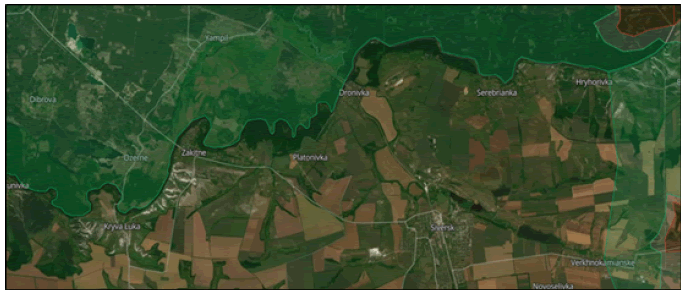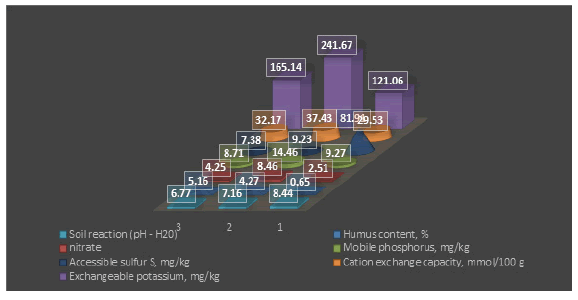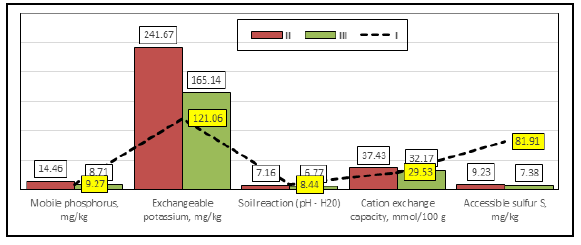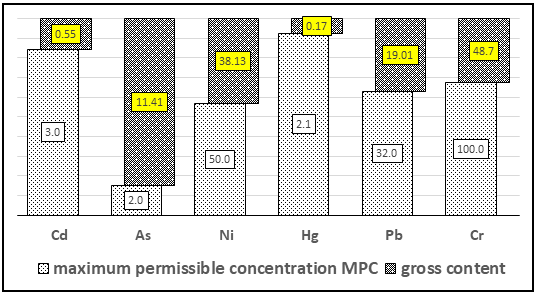Research - Modern Phytomorphology ( 2025) Volume 19, Issue 3
Agricultural and military transformation of the black earth and its reclamation
Oleksandr Mytsyk1, Oleksandr Havriushenko1, Sergey Shevchenko1*, Oleksandr Tsyliuryk2, Vitalii Rudas1, Kurshakov1, Vitalii Hrabko3 and David Dent32Dept Plant Science, Dnipro State Agrarian and Economic University, Dnipro, Ukraine
3Independent Researcher, Chestnut Tree Farm, Forncett End, Norfolk, England
Sergey Shevchenko, Department of General Agriculture and Soil Science, Dnipro State Agrarian and Economic University, Dnipro, Ukraine, Email: shevchenko.s.m@dsau.dp.ua
Received: 14-Feb-2025, Manuscript No. mp-25-161342; Accepted: 13-Mar-2025, Pre QC No. mp-25-161342 (PQ); Editor assigned: 17-Feb-2025, Pre QC No. mp-25-161342 (PQ); Reviewed: 01-Mar-2025, QC No. mp-25-161342 (Q); Revised: 07-Mar-2025, Manuscript No. mp-25-161342 (R); Published: 19-Mar-2025, DOI: 10.5281/zenodo.17118527
Abstract
Under conditions of intensive anthropogenic impact caused by developed industry, agriculture, and military actions, the problem of chernozem degradation has become particularly relevant. Changes in the morphogenetic characteristics, chemical composition, and physico-chemical properties of the soil require a detailed analysis to develop effective reclamation strategies. The aim of this study was to assess the extent of chernozem degradation under the influence of artillery shelling and agricultural use and to evaluate the possibilities for its reclamation. The methods included field studies, soil sampling in the Bakhmut and Siversk regions, agrochemical analysis according to the methodology of Balyuk and Yatsuk, determination of physico-chemical properties, and assessment of heavy metal content using ICP-MS spectrometry. The results demonstrated significant changes in humus content, macro- and microelement composition. The crater formed by a 152-mm artillery shell explosion was characterised by a catastrophic decline in humus content (0.65% compared to 4.27% in arable land and 5.16% in virgin soil). An increase in pH to 8.44, a 8.9-fold rise in mobile sulphur concentration, and a sharp increase in heavy metal content were observed. Particularly critical was the arsenic content, exceeding the Maximum Permissible Concentration (MPC) by 5.7 times, indicating severe military-technogenic contamination. Additionally, local depletion of nitrate nitrogen, potassium, and magnesium in the explosion zone was recorded, significantly reducing the soil’s fertility potential. The conclusions confirm that military actions cause severe disruptions in agroecosystems. Effective land reclamation should involve a phased restoration of soil structure through green manuring, organic fertilisation, and the implementation of adaptive land-use systems.
Keywords
Soil degradation, Heavy metals, Explosive impact, Fertility restoration, Environmental safety
Introduction
Farmers for forty centuries, and agricultural science for three or more, have known that humus is fundamental to soil fertility (King, 1911, Wallerius and Gyllenburg, 1761, Thaer, 1809, Liebig, 1859). Nowhere more so than on the steppes, where the black earth boasts a humus horizon up to a metre thick with a natural humus content of up to 12 per cent. But more than a century under the plough has burned off two thirds of that humus (Lal, 2004, Kovda, 1983) and now, not for the first time, the steppes are a battlefield and the soil is a casualty (Dmytruk, et al. 2023). Here we examine the extent of these human impacts on the black earth: Its morphology, ecology, chemical and physical properties, and composition in particular, its pollution with heavy metals that impair the growth and development of crops and public health. And we propose a plan to reclaim the land.
Material and Methods
The object of the study is the medium-humus, thick chernozem of the Bakhmut and Siver communities of the, studied according to the methodology of Baliuk and Yatsuk, 2018. Elemental analysis of soil samples under No. 0702-24-S was carried out at VSP Institute of Plant Health LLC at UKRAVIT Science Park (Fig. 1).
Figure 1. Locations.
Our purpose is to study changes in the properties of ordinary black earth and the content of heavy metals in the 0-40cm layer as affected by:
- Explosion of a 152mm artillery shell, in 2024
- Arable farming, results of agrochemical analysis for 2020
- Control profile under fallow 2020
Results and Discussion
Indicator, units of measurement and variants (Tab. 1).
| Indicator, units of measurement | Variants | |||
|---|---|---|---|---|
| I | II | III | ||
| Humus content, % | 0.65 ± 0.05 | 4.27 ± 0.41 | 5.16 ± 0.17 | |
| Content of nitrogenous compounds, mg/kg | Easily hydrolysed | 14.02 ± 3.05 | Not determined | 114.83 ± 5.58 |
| Nitrate | 2.51 ± 0.75 | 8.46 ± 0.88 | 4.25 ± 2.23 | |
| Ammonium | 1.14 ± 0.33 | Not determined | Not determined | |
| Mobile phosphorus, mg/kg | 9.27 ± 2.11 | 14.46 ± 8.91 | 8.71 ± 3.37 | |
| Exchangeable potassium, mg/kg | 121.06 ± 19.02 | 241.67 ± 24.17 | 165.14 ± 13.08 | |
| Soil reaction (pH-H2O) | 8.44 ± 0.12 | 7.16 ± 0.38 | 6.77 ± 0.16 | |
| Cation exchange capacity, mmol/100 g | 29.53 ± 2.27 | 37.43 ± 1.46 | 32.17 ± 1.06 | |
| Mobile sulphur, mg S/kg | 81.91 ± 13.54 | 9.23 ± 5.84 | 7.38 ± 0.82 | |
| Microelements, mg/kg | B | 0.88 ± 0.29 | 1.83 ± 0.86 | 0.27 ± 0.11 |
| Fe | 3.81 ± 1.05 | 84.31 ± 21.58 | Not determined | |
| Mn | 8.82 ± 2.03 | 57.33 ± 13.86 | 34.26 ± 5.71 | |
| Cu | 0.13 ± 0.06 | 1.67 ± 0.44 | 1.17 ± 0.18 | |
| Zn | 0.44 ± 0.16 | 1.28 ± 0.35 | 0.56 ± 0.14 | |
Table 1. Physico-chemical characteristics, 0-40 cm layer.
Unsurprisingly, the most important indicator of soil fertility-humus-differed significantly in the shell crater compared with the entire soil profiles: 0.65% compared with 4.27% in the arable topsoil and 5.16% under fallow; compared with the control, the humus content was less by 17% under arable but less by 87% in the crater (Figs. 2,3) blown up along with every living thing.
Figure 2. Characterization of macro-elements.
Figure 3. Comparative edaphic case study locations.
Accordingly, there was a parallel decrease in the content of nitrogenous compounds; nitrates in variant I amounted to 2.51 mg/kg and, in variants II and III, 8.46 and 4.25 mg/kg, respectively. Mobile phosphorus was at similar levels in all three: 8.71-14.46 mg/kg. Exchangeable potassium much lower in I: 121 mg/kg as against 242 and 165 mg/kg in variants II and III. pHwater increased from 6.77 to 8.44 as a result of the explosion and the content of mobile sulphur was 9.2 and 7.4 mg/kg in variant II and in the control, respectively, but 81.9 mg/kg in the crater-an increase of an order of magnitude.
Heavy metals
Continually increasing levels of toxic heavy metals and arsenic in soils, in arable soils in particular, has been a characteristic of the Anthropocene. Tab. 2 and Fig.4 present the data for our small sample.
| Indicator, units of measurement | Variant | ||||
|---|---|---|---|---|---|
| I | II | III | |||
| Cadmium, mg/kg | Gross content | 0.55 ± 0.19 | 0.36 ± 0.13 | 0.31 ± 0.11 | |
| MPC | 3.0 | ||||
| Arsenic, mg/kg | Gross content | 11.41 ± 2.53 | 0.58 ± 0.07 | 0.26 ± 0.03 | |
| MPC | 2.0 | ||||
| Nickel, mg/kg | Gross content | 38.13 ± 7.02 | 11.92 ± 0.15 | 10.14 ± 0.17 | |
| MPC | 50.0 | ||||
| Mercury, mg/kg | Gross content | 0.17 ± 0.07 | 0.03 ± 0.002 | 0.02 ± 0.001 | |
| MPC | 2.1 | ||||
| Lead, mg/kg | Gross content | 19.01 ± 3.91 | 1.42 ± 0.82 | 0.93 ± 0.11 | |
| MPC | 32.0 | ||||
| Chromium, mg/kg | Gross content | 48.7 ± 8.71 | 18.11 ± 1.06 | 17.07 ± 1.08 | |
| MPC | 100.0 | ||||
Table 2. Content of heavy metals in soil samples (0-40 cm layer) MPC, maximum permissible concentration.
Figure 4. Correlation between gross content and MPC heavy metals in variant I.
They indicate exceedance of the maximum permissible concentration (MPC, 2021) of arsenic; its concentration coefficient was 5.7, and a high levels of nickel, lead and chromium resulting from a single 152 mm artillery shell giving concentration coefficients of: As (5.7)>Ni (0.8))>Pb(0.6)>Cr (0.5)>Cd (0.2)>Hg (0.1).
These data strongly suggest that the exceedance of the MPC for arsenic in the studied soils was caused by the detonation of the shell. Significantly, Biyashev et al. 2024, drawing on substantial sampling across the combat zone, report concentrations of iron, zinc, cadmium, lead and copper exceeding MPC by 1.5 to 3-fold; and concentrations of barium, nickel, arsenic and phosphorus exceeding MPC by about 4-fold as a result of detonation of munitions and inherited pollution by heavy industry. This pollution affects not only technogenic but, also, biogenic territories. Heavy metals accumulate soils and vegetation and enter the metabolic cycles of living organisms, forming toxic, carcinogenic, organometallic compounds.
What to do about it?
Unfortunately, to survive the Russian assault, we have to resist with artillery of our own. Then, facing a cratered and polluted landscape, we need to level it and restore the soils. The black earth was created by grassland and earthworms. Therefore, we propose a national program of land reclamation, as demonstrated by Professors Uzbek and Horobets, 1975 and Kharytonov, et al. 2018, simply by growing crops but accelerated by a national program of filling the craters with sewage sludge-that will replace the humus, feed the worms, and solve several problems at once-and we shall have the last laugh (Mytsyk O, et al. 2024).
Conclusions
Modern warfare can rapidly strip ordinary chernozem of fertility. In the shell-impacted site, humus fell to 0.65% (vs. 4.27% in arable and 5.16% under fallow), with depressed N and K, alkalization to pH 8.44, and a ~10 × rise in mobile S. Arsenic reached 11.41 mg/ kg (~5.7 × MPC), with Ni, Pb, and Cr elevated though below MPC-evidence of acute blast-driven contamination superimposed on prior anthropogenic pressure. These shifts threaten crop productivity and raise food-chain risks; routine inputs will not suffice for recovery.
Priority actions: Clear UXO/metal debris and regrade; rebuild/top up topsoil; stabilize as in situ (iron-rich sorbents, compatible mineral amendments); restore organic matter with certified stabilized biosolids/composts; revegetate with perennial grasses/legumes then diversify rotations; monitor metal mobility and crop uptake to verify risk reduction. Findings are site-specific; broader sampling and field trials are needed to scale this reclamation approach.
References
- King FH. (1911). Farmers for forty centuries (Madison WI: Mrs F.H. King).
- Wallerius JG, Gyllenburg GA. (1761). Agriculturae fundamenta chemica: Åkerbrukets chemiska Grunder. (Uppsala: in Latin and Swedish).
- Thaer AD. (1821). Grundsätze der rationellen Landwirthschaft. G. Reimer.
- von Liebig JF. (1859). Familiar letters on chemistry, and its relation to commerce, physiology, and agriculture. Walton and Maberly.
- Lal R. (2004). Soil carbon sequestration impacts on global carbon change and food security. Science. 34:1623-27.
- Dmytruk Y, Cherinka V, Dent DL. (2023). Soils in war and peace. Int J Environ Stud. 80:380-393.
- Baliuk S, Yatsuk I. (2019). Methodology of agrochemical certification of agricultural lands: Regulatory document. 2nd ed., supplement K. (Kharkiv, in Ukrainian).
- MPC. (2021). On the approval of standards for maximum permissible concentrations of hazardous substances in soils, as well as the list of such substances.
- Biyashev B, Drobitko A, Markova N, Bondat A. (2024). Chemical analysis of the state of Ukrainian soils in the combat zone. Int J Environ Stud. 81:199-207.
- Uzbek IK, Horobets ND. (1975). Experience of cultivating perennial leguminous grasses on tertiary clayey deposits. Land Reclamation of Lands Disturbed by Mineral Extraction. (Dnipropetrovsk: Ahrarna science, in Ukrainian).
- Kovda V. (1983). Russian chernozem 100 years after Dokuchaev. Moscow, Nauka (Russian).
- Kharytonov MM, Babenko MH, Mytsyk OO, Gavryushenko OO, Martynova NV. (2018). Physical-chemical and biological testing of phytomeliorated rocks of the Pokrov land reclamation station. Agrology. 1:300-305.
- Mytsyk O, Havryushenko O, Tsyliuryk O, Shevchenko S, Hulenko O, Shevchenko M, Derevenets-Shevchenko K. (2024). Reclamation of derelict mine land by simply growing crops.Int J Environ Stud. 81:230-8.



